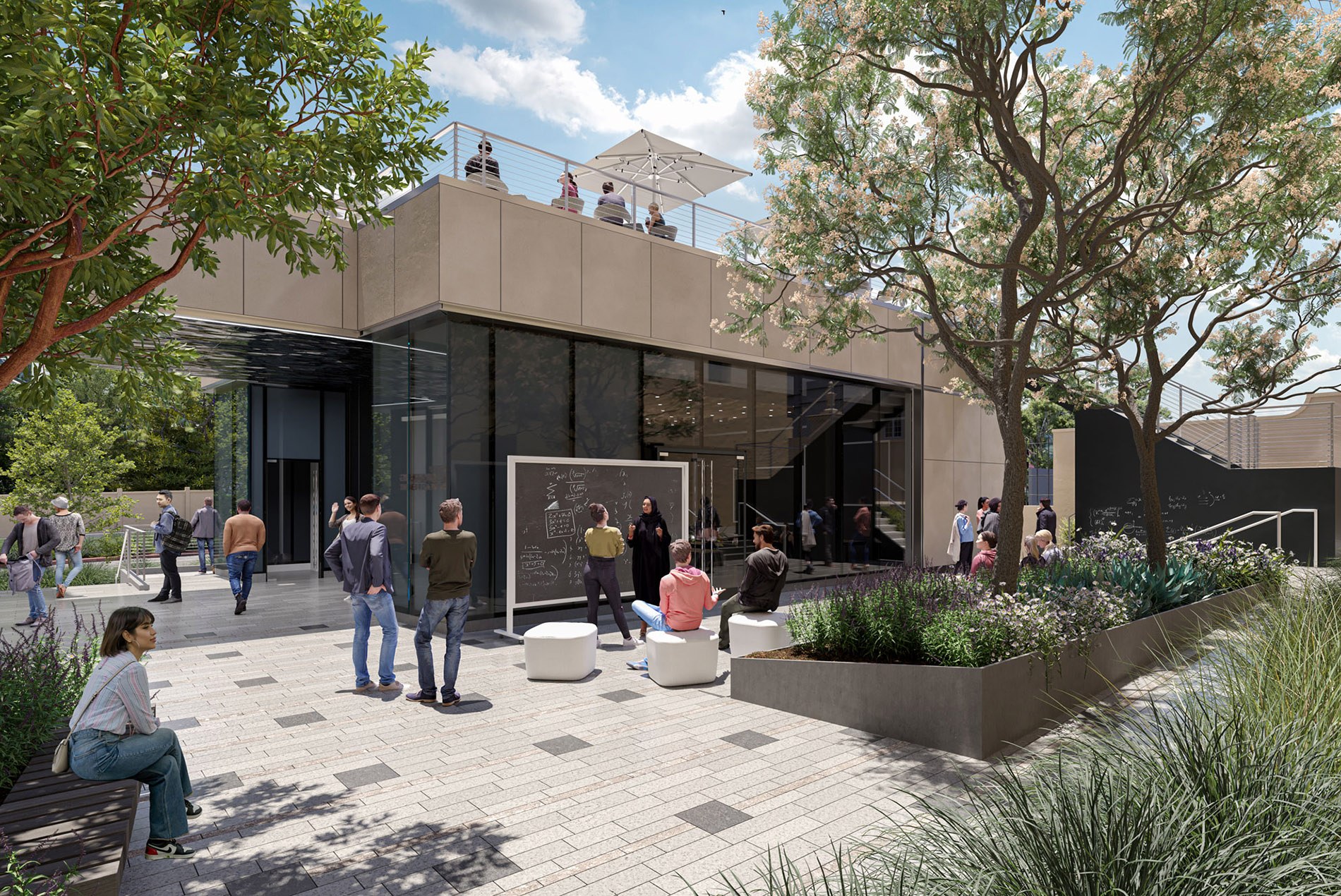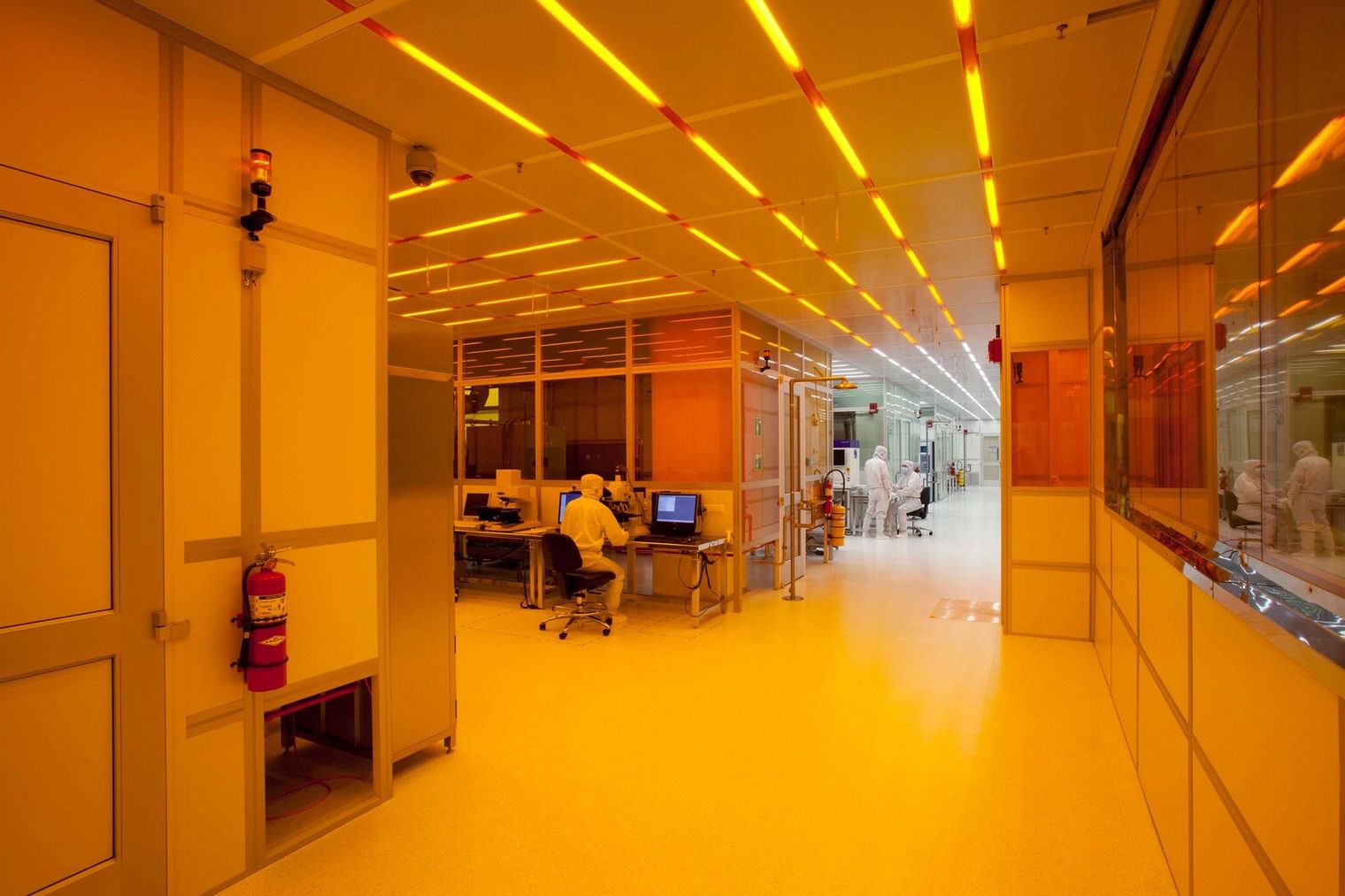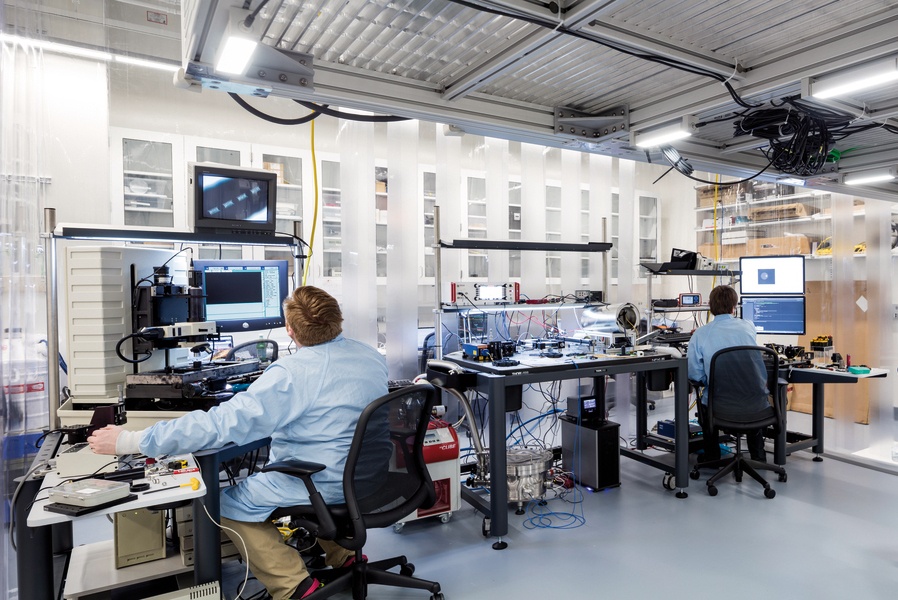HOK’s Leslie Ashor and Matt Williamson discuss why quantum research facilities need to be designed for extreme precision, reliability and adaptability.
Quantum computing is poised to solve complex simulation and optimization problems that are simply impossible for today’s supercomputers. Information in traditional computers is stored in bits that remain in a fixed state: either a one or a zero. By contrast, quantum computing uses “qubits” that can exist in superposition—they can be a one, a zero or a weighted combination of both until measured. Ashor likens this to a spinning billiard ball that can operate in countless orientations while it’s in motion. Qubits can also be entangled, meaning their states are correlated even across distance. This ability to explore many outcomes in parallel can deliver dramatic speedups for specific problem types.
Why Quantum Matters Now
When paired with AI, error-corrected qubits could revolutionize many areas of research. Yet these systems require extraordinary conditions that push the limits of building design. One leading quantum computing approach uses superconducting chips. These chips are operated at temperatures near absolute zero and must be shielded from ambient heat and everyday electromagnetic “noise.” Even small things—the electrical hum of a building, a nearby elevator starting up or a phone searching for a signal—can throw off a quantum calculation.
“Quantum” sounds like sci-fi, but its basics are a century old. Albert Einstein won the 1921 Nobel Prize for explaining the photoelectric effect, showing that light comes in discrete packets, or photons. This is a foundation of quantum theory and powers technologies from automatic doors and laser pointers to the chips in our devices. To mark 100 years of progress, UNESCO designated 2025 the International Year of Quantum Science and Technology.
Pushing Quantum Forward
What is new is the race to harness these principles for computing. Tech giants like Google, Microsoft, Amazon and IBM are all working to commercialize the technology. Denmark’s Novo Nordisk Foundation and Export and Investment Fund just announced plans for “Magne,” a 50-logical-qubit commercial quantum computer (a key metric of computing power representing stable, error-corrected qubits) built by Atom Computing with software from Microsoft. Targeting drug discovery and materials science, this computer is scheduled to begin operating by late 2026 or early 2027. This will be a major step toward a quantum-powered future.
HOK is addressing the complex challenges that come with designing these labs, which require unique space and infrastructure, for quantum projects including Caltech’s Dr. Allen and Charlotte Ginsburg Center for Quantum Precision Measurement in Pasadena.
In this Q+A, Leslie Ashor, AIA, LEED AP, director of HOK’s Science + Technology practice, and Matt Williamson, PE, engineering practice leader, share insights on challenges faced by teams that design facilities that support quantum functions.

Caltech’s Dr. Allen and Charlotte Ginsburg Center for Quantum Precision Measurement in Pasadena
What makes quantum research different from a traditional laboratory?
Leslie: Quantum research pushes design to extremes we rarely see in traditional labs. At Caltech, we buried most of the quantum facility 28 feet underground on a 3-foot-thick concrete slab to minimize interference from noise, light and the vibration from a main boulevard on the edge of the site.
While a typical biology lab might need 6 to 15 air changes per hour, some spaces in quantum laboratories are cleanrooms that can require 30 to 40 air changes per hour in bays, with small ISO-4 enclosures effectively reaching the hundreds. The infrastructure demands are extreme. The superconducting quantum computers require extreme conditions with the dilution refrigerator—temperatures around minus 270 degrees Celsius and a high-vacuum cryostat. These systems can cost many millions of dollars per computer. Other types of quantum computers use optics and lasers, requiring extremely stable temperature, humidity and vibration control, in addition to an extremely high cleanliness level.
The users are also different. Quantum researchers are very hands-on do-it-yourselfers who build their own equipment and need immediate access to electronics workshops and fabrication spaces.
Why do dilution refrigerators drive so many engineering decisions?
Matt: It’s a classic engineering problem: creating extreme cold generates extreme heat elsewhere. Dilution refrigerators use cryocompressors to help achieve the extremely low temperatures. The heat of compression must be removed from the cryocompressor without creating environmental heat. We engineer specialized process- cooling water loops to handle it. And those loops are sensitive. They need extremely clean water or the equipment’s delicate cooling channels will get fouled. The cooling systems are also running within a tightly controlled temperature range for stable performance.
Beyond that, you have a cascade of other needs: bulk liquid nitrogen storage, specialized vacuum systems and incredible facility resilience. Clients invest months getting these systems operational, so unexpected downtime is not an option. This is why we design resilience into the facility infrastructure from the beginning.
On top of all that, you have the environmental sensitivity. These systems are easily disrupted by the smallest amount of electromagnetic interference or vibration. As engineers, every choice is viewed through the lens of protecting the quantum computing equipment.

King Abdullah University of Science and Technology in Thuwal, Saudi Arabia
How do you design to give hands-on scientists flexibility without compromising cleanliness or safety?
Leslie: Quantum researchers are constantly building and modifying their own equipment. They often use modular systems like 80/20 aluminum extrusion. To support them, we design for hyperflexibility. This concept includes generous clearances for future equipment, easily expandable utility pathways and abundant plug connections so they don’t have to tear into walls for every modification.
For cleanliness, it’s about creating layers of control. While some experiments need full “bunny suit” cleanrooms, we’ve also designed specialized, HEPA-filtered enclosures for sensitive work like optics and lasers. This layered approach means the main lab space for the dilution refrigerators can be a controlled-air environment—clean, but without the strict gowning protocols that prevent researchers from easily making adjustments.
Safety and performance are supported through smart zoning. We strategically separate dirty processes and noisy, vibrating support equipment like vacuum pumps and compressors from the research space, into shared corridors or equipment rooms. By running services through sleeves in the wall, the sensitive quantum equipment stays protected in a stable environment, while the researchers still have access to the infrastructure pathways they need to tinker with.
What are the non-negotiables for uptime?
Matt: There’s little tolerance for unexpected downtime. An unplanned power or cooling failure can destroy weeks of research, so reliability is an absolute priority.
We design extreme resilience into the facility’s core infrastructure. We’re engineering uninterruptible power supplies for entire buildings. One client requested 10 minutes of facility-wide UPS coverage just to avoid potential voltage spikes during a generator startup. For backup power, we provide backup generation for anywhere from a few hours to three days of generator capacity, depending on the client’s risk profile.
The cooling systems are another big driver. The cooling load from the research equipment alone can be 10 times greater than the building’s needs for environmental comfort. So, the equipment, not the people or the location, dictates the entire cooling system design.

University of Chicago William Eckhardt Research Center
Where do project teams most often stumble?
Leslie: The biggest stumbles often happen during the translation of scientific needs into architectural reality. For example, a researcher may say they need a cleanroom, but what that means can vary wildly. We’ve found that often they just need a “clean-ish” space with good filtration, not a full ISO-rated cleanroom that requires expensive infrastructure and strict gowning protocols.
I always ask simple questions to get to the heart of it: “What are you willing to do to suit up? No smoking before entering? No perfume or cologne? Will you use paper in the space?” Their answers tell me the true level of cleanliness they actually require. This helps ensure the client doesn’t pay for—or have to operate and maintain—more than they need.
The sheer amount of support equipment and infrastructure required for even one dilution refrigerator is surprising to people.
Another challenge is that quantum science evolves so rapidly. We’re often designing facilities for equipment that we can’t even identify yet, which makes designing for the future critical. Change is constant so we have to think a few steps ahead to address what is coming.
How can owners future-proof when quantum platforms keep shifting?
Matt: It’s important to understand the client’s entire roadmap. We focus on their initial build-out, how much cooling and power they’ll need initially, and how they plan to expand in the future. This allows us to design the core infrastructure with the ability to either be enlarged later or have that extra capacity built in from the beginning. Getting this right is essential, especially for cooling, which is driven by research loads instead of comfort.
Leslie: Exactly. From a space planning perspective, a lot of our strategy is about designing for equipment and uses that don’t exist yet. On the Caltech quantum project, a portion of the facility was designed as shell space that’s ready for future build-out as the science evolves. This gives them long-term adaptability.
It’s also why workshops and fabrication spaces are so critical. We know these researchers build so much of their own equipment. Giving them a wide range of dedicated space to innovate and repair things nearby means the facility can adapt alongside the technology without requiring constant, major renovations.
 Let’s Connect
Let’s Connect
Considering a quantum program? HOK’s Science + Technology group brings decades of experience designing advanced research facilities, including quantum labs for leading institutions like Caltech, KAUST and the University of Chicago, along with complex labs for tech giants and pharmaceutical companies worldwide. Contact leslie.ashor@hok.com or matt.williamson@hok.com to begin the conversation.
Feature image: Oak Ridge National Laboratory (Andy Sproles/ORNL, U.S. Dept. of Energy), adapted from Wikimedia Commons, CC BY 2.0.
Richard Feynman image: Richard Feynman, Nobel portrait, The Nobel Foundation. Public domain. Source: Wikipedia.
